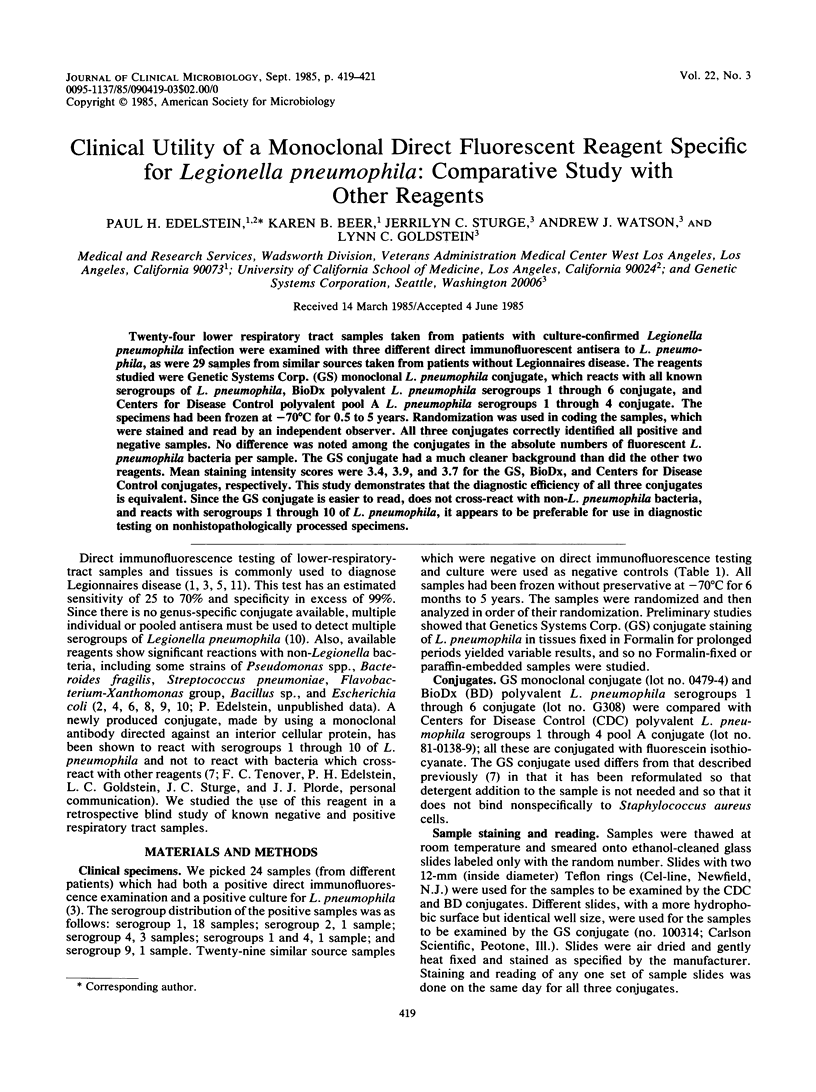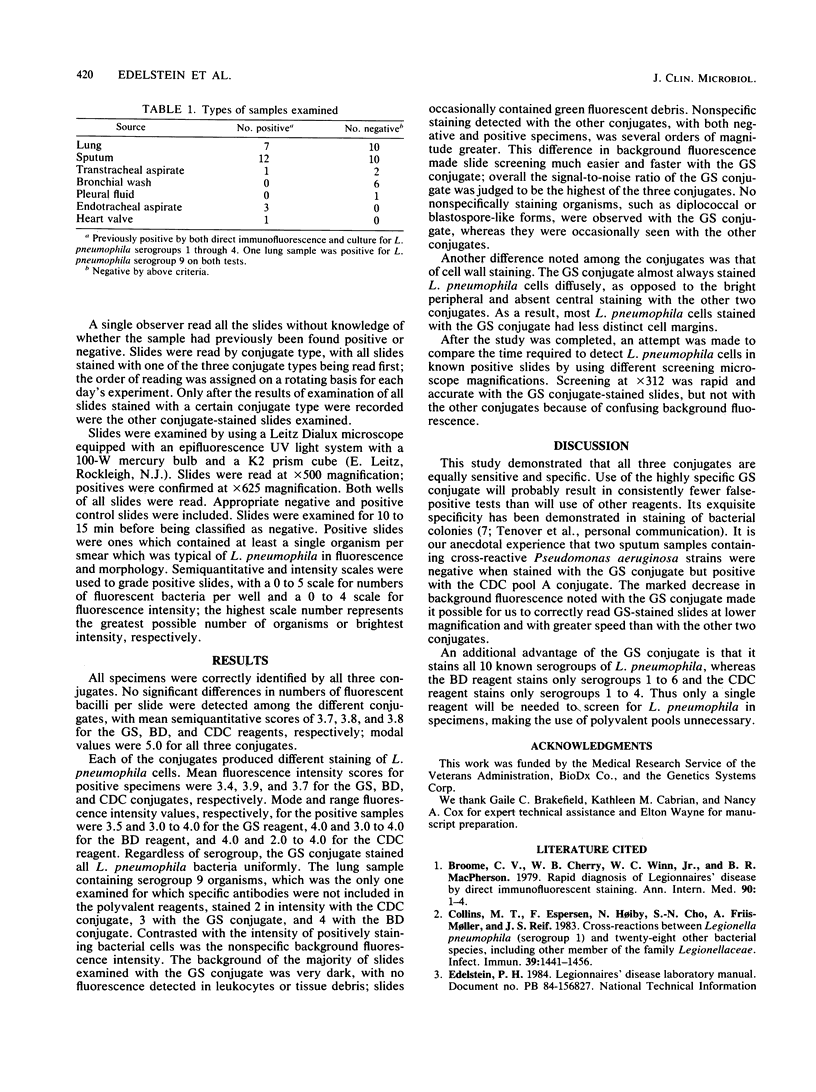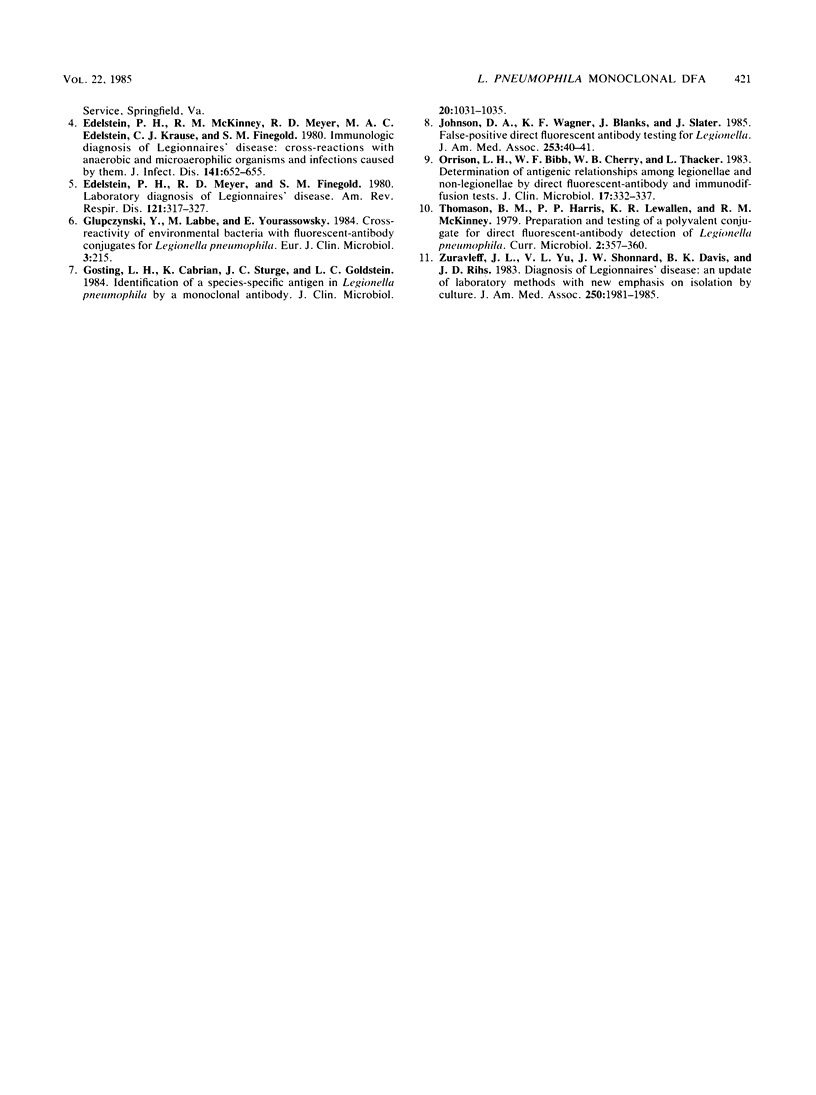Abstract
Twenty-four lower respiratory tract samples taken from patients with culture-confirmed Legionella pneumophila infection were examined with three different direct immunofluorescent antisera to L. pneumophila, as were 29 samples from similar sources taken from patients without Legionnaires disease. The reagents studied were Genetic Systems Corp. (GS) monoclonal L. pneumophila conjugate, which reacts with all known serogroups of L. pneumophila, BioDx polyvalent L. pneumophila serogroups 1 through 6 conjugate, and Centers for Disease Control polyvalent pool A L. pneumophila serogroups 1 through 4 conjugate. The specimens had been frozen at -70 degrees C for 0.5 to 5 years. Randomization was used in coding the samples, which were stained and read by an independent observer. All three conjugates correctly identified all positive and negative samples. No difference was noted among the conjugates in the absolute numbers of fluorescent L. pneumophila bacteria per sample. The GS conjugate had a much cleaner background than did the other two reagents. Mean staining intensity scores were 3.4, 3.9, and 3.7 for the GS, BioDx, and Centers for Disease Control conjugates, respectively. This study demonstrates that the diagnostic efficiency of all three conjugates is equivalent. Since the GS conjugate is easier to read, does not cross-react with non-L. pneumophila bacteria, and reacts with serogroups 1 through 10 of L. pneumophila, it appears to be preferable for use in diagnostic testing on nonhistopathologically processed specimens.
Full text
PDF


Selected References
These references are in PubMed. This may not be the complete list of references from this article.
- Broome C. V., Cherry W. B., Winn W. C., Jr, MacPherson B. R. Rapid diagnosis of Legionnaires' disease by direct immunofluorescent staining. Ann Intern Med. 1979 Jan;90(1):1–4. doi: 10.7326/0003-4819-90-1-1. [DOI] [PubMed] [Google Scholar]
- Collins M. T., Espersen F., Høiby N., Cho S. N., Friis-Møller A., Reif J. S. Cross-reactions between Legionella pneumophila (serogroup 1) and twenty-eight other bacterial species, including other members of the family Legionellaceae. Infect Immun. 1983 Mar;39(3):1441–1456. doi: 10.1128/iai.39.3.1441-1456.1983. [DOI] [PMC free article] [PubMed] [Google Scholar]
- Edelstein P. H., McKinney R. M., Meyer R. D., Edelstein M. A., Krause C. J., Finegold S. M. Immunologic diagnosis of Legionnaires' disease: cross-reactions with anaerobic and microaerophilic organisms and infections caused by them. J Infect Dis. 1980 May;141(5):652–655. doi: 10.1093/infdis/141.5.652. [DOI] [PubMed] [Google Scholar]
- Edelstein P. H., Meyer R. D., Finegold S. M. Laboratory diagnosis of Legionnaires' disease. Am Rev Respir Dis. 1980 Feb;121(2):317–327. doi: 10.1164/arrd.1980.121.2.317. [DOI] [PubMed] [Google Scholar]
- Glupczynski Y., Labbe M., Yourassowsky E. Cross-reactivity of environmental bacteria with fluorescent-antibody conjugates for Legionella pneumophila. Eur J Clin Microbiol. 1984 Jun;3(3):215–215. doi: 10.1007/BF02014884. [DOI] [PubMed] [Google Scholar]
- Gosting L. H., Cabrian K., Sturge J. C., Goldstein L. C. Identification of a species-specific antigen in Legionella pneumophila by a monoclonal antibody. J Clin Microbiol. 1984 Dec;20(6):1031–1035. doi: 10.1128/jcm.20.6.1031-1035.1984. [DOI] [PMC free article] [PubMed] [Google Scholar]
- Johnson D. A., Wagner K. F., Blanks J., Slater J. False-positive direct fluorescent antibody testing for Legionella. JAMA. 1985 Jan 4;253(1):40–41. doi: 10.1001/jama.253.1.40b. [DOI] [PubMed] [Google Scholar]
- Orrison L. H., Bibb W. F., Cherry W. B., Thacker L. Determination of antigenic relationships among legionellae and non-legionellae by direct fluorescent-antibody and immunodiffusion tests. J Clin Microbiol. 1983 Feb;17(2):332–337. doi: 10.1128/jcm.17.2.332-337.1983. [DOI] [PMC free article] [PubMed] [Google Scholar]
- Zuravleff J. J., Yu V. L., Shonnard J. W., Davis B. K., Rihs J. D. Diagnosis of Legionnaires' disease. An update of laboratory methods with new emphasis on isolation by culture. JAMA. 1983 Oct 21;250(15):1981–1985. doi: 10.1001/jama.250.15.1981. [DOI] [PubMed] [Google Scholar]


